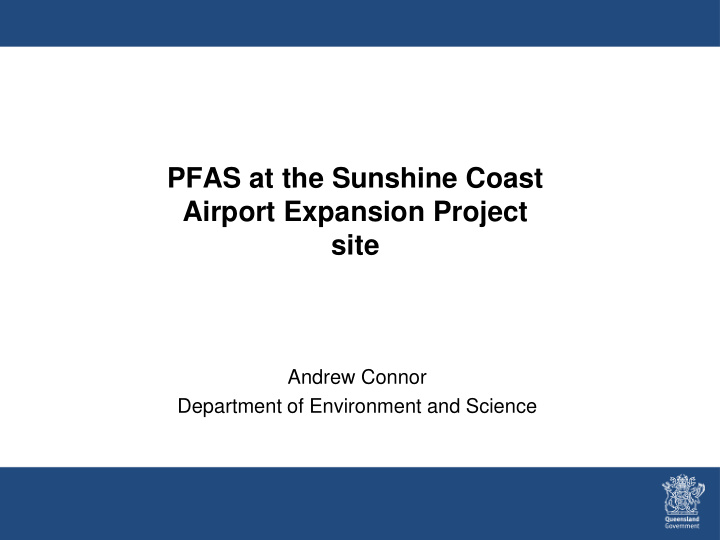



PFAS at the Sunshine Coast Airport Expansion Project site Andrew Connor Department of Environment and Science
PFOS PFOA About PFAS • Per and poly-fluoroalkyl substances (PFAS) such as PFOS and PFOA are a group of manufactured chemicals. • PFAS have not been manufactured in Australia. • PFAS have been used since the 1950s in common household products, including non-stick cookware, fabric, furniture and carpet stain protection applications and food packaging. • PFAS have also been previously used in some industrial processes, including in certain types of fire-fighting foams.
Queensland Firefighting Foam Policy • July 2016 • Bans use of firefighting foams containing persistent chemicals. • Management standards that need to be met by users. • Sets practices for foam handling, use and disposal in accordance with the Environmental Protection Act 1994. • Stricter environmental controls for all foams. • Industrial sites directly engaged by DES to educate about the foam ban – wide success in the reduction of use.
PFAS National Environmental Management Plan (NEMP) • January 2018 • Collaboration between states, territories and Australian Government. • Reflects increasing scientific knowledge relevant to environmental regulation of PFAS. • Sets standards for environmental guidelines values to protect human health and ecosystems.
Qld ambient PFAS monitoring – May results (55 sites) PFOS Hazard Quotient Aquatic Ecosystem 95% protection level Hazard quotient = concentration in river / guideline value <1 means low risk Noosa River Maroochy River Caboolture River Brisbane River Logan River
PFAS at the Airport • PFAS use at airport ceased in 2010. • Site not used as a training facility. • Fire-fighting foam used in 2 light aircraft crashes NW of existing runway in 2005 and 2006. • Accidental releases from tanks at fire stations. • Performance testing and washdown of fire-fighting equipment. • Relocation of soils during drainage works (since removed from site).
Maroochy river • Shows local protected areas relevant to marine ecology. • State significant wetlands and national parks (green). • Contain endangered fauna protected under State and Commonwealth laws. • Fish habitat areas (purple and aqua)
Ocean environment • Study of seabed and fauna as part of the EIS. • Seabed surveys in the area shown (black lines and green points). • Sparse fauna present, not of conservation significance. • Lack of diversity. • Contrasts with Maroochy River.
Seabed survey • Sparse fauna present on shifting sands. • Occasional swimmer crabs, mole crabs, sea cucumbers (holothurians), sea stars (asteroids) and bivalve molluscs. • Large epifauna were rarely sighted during video transects. • Grab samples frequently contained several small heart urchins.
Impacts of release • DES technical advice is that PFAS at the low concentrations present in the water proposed to be released is not expected to impact biodiversity of the area of seabed offshore. • The key risk considered by DES is whether bioaccumulation may occur, which is highly unlikely given the significant mixing, large dispersion, saline environment and the scarcity of fauna at the proposed release point. • DES regulatory oversight of the release will occur through the Environmental Authority, Tidal Works permit, PFAS NEMP and the Environmental Protection Act 1994 .
Recommend
More recommend